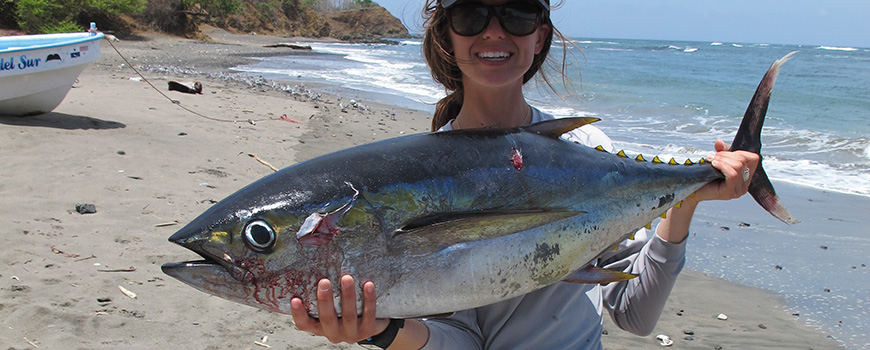Global S&T Development Trend Analysis Platform of Resources and Environment
| Location, Location, Location: Pollutant Levels in Tuna Depend on Where They Are Caught | |
| admin | |
| 2017-08-03 | |
| 发布年 | 2017 |
| 语种 | 英语 |
| 国家 | 美国 |
| 领域 | 资源环境 |
| 正文(英文) |  Yellowfin tuna Researchers at Scripps Institution of Oceanography at the University of California San Diego found levels of persistent organic pollutants as much as 36 times higher in the muscle tissue of yellowfin tuna caught in the more industrialized areas of the northeast Pacific Ocean and northeast Atlantic Ocean than in tuna caught in pristine waters of the West Pacific Ocean. Persistent organic pollutants (POPs) include pesticides, flame retardants, and polychlorinated biphenyls (PCBs) – compounds previously used as a coolant in electrical equipment and components before they were banned in the United States in 1979. Despite their restricted or eliminated use, these compounds persist in the environment and ultimately accumulate in organisms, including fish and humans. POPs have a number of adverse effects in humans, including interference with the body’s defenses against foreign substances. Most of the 117 tuna caught around the world analyzed in the study would be considered safe under current consumption guidelines, the researchers said. However, they noted that 90 percent of the tuna captured in the northeast Atlantic Ocean and more than 60 percent of those caught in the Gulf of Mexico contained pollutant levels that would have triggered health advisories for regular consumers and people at risk, including pregnant and nursing women or people with compromised immune systems. The authors also found levels of a specific subset of these pollutants that is known to impair the human body’s defense system against chemicals and toxins. This group of pollutants is known as Transporter Inhibiting Compounds (TICs). Surprisingly, TICs were present in all tuna with the highest levels again detected in the most contaminated sites. “Surprisingly, only a few types of pollutants detected in tuna had regulatory information available to calculate meal recommendations,” said Scripps postdoctoral researcher Sascha Nicklisch, who led the study. “An important issue raised by the study is how to guide science and policy on possible hazards associated with these chemicals in our food sources.” The study appears in the July issue of the journal Environmental Health Perspectives, which is published by the National Institute of Environmental Health Sciences. Researchers previously had found a correlation between the amount of pollutants and the body fat percentage of the fish since the pollutants accumulate in lipids. In this study, however, Nicklisch’s team found that the level of pollutants was often more closely correlated with the location where the fish were caught rather than the amount of fat in the fish. While the researchers could not establish a clear relationship, their data shows that the fat content in itself is not always a sufficient predictor of the overall pollutant load of fish. The study suggests that catch location should be used to guide consumer choices and to help reduce unintended human exposure to these pollutants. Co-authors of the paper include Scripps marine biologists Lindsay Bonito, Stuart Sandin, and Amro Hamdoun. This work was supported by National Institutes of Health grant ES021985, by National Science Foundation grant 1314480 to Hamdoun, and by a Waitt Foundation grant to Hamdoun and Sandin.
Note to broadcast and cable producers: University of California San Diego provides an on-campus satellite uplink facility for live or pre-recorded television interviews. Please phone or email the media contact listed above to arrange an interview.
About Scripps OceanographyScripps Institution of Oceanography at the University of California San Diego, is one of the oldest, largest, and most important centers for global science research and education in the world. Now in its second century of discovery, the scientific scope of the institution has grown to include biological, physical, chemical, geological, geophysical, and atmospheric studies of the earth as a system. Hundreds of research programs covering a wide range of scientific areas are under way today on every continent and in every ocean. The institution has a staff of more than 1,400 and annual expenditures of approximately $195 million from federal, state, and private sources. Scripps operates oceanographic research vessels recognized worldwide for their outstanding capabilities. Equipped with innovative instruments for ocean exploration, these ships constitute mobile laboratories and observatories that serve students and researchers from institutions throughout the world. Birch Aquarium at Scripps serves as the interpretive center of the institution and showcases Scripps research and a diverse array of marine life through exhibits and programming for more than 430,000 visitors each year. Learn more at scripps.ucsd.edu and follow us at Facebook, Twitter, and Instagram.About UC San DiegoAt the University of California San Diego, we constantly push boundaries and challenge expectations. Established in 1960, UC San Diego has been shaped by exceptional scholars who aren’t afraid to take risks and redefine conventional wisdom. Today, as one of the top 15 research universities in the world, we are driving innovation and change to advance society, propel economic growth, and make our world a better place. Learn more at www.ucsd.edu.
|
| URL | 查看原文 |
| 来源平台 | Scripps Institution of Oceanography |
| 文献类型 | 新闻 |
| 条目标识符 | http://119.78.100.173/C666/handle/2XK7JSWQ/107544 |
| 专题 | 资源环境科学 |
| 推荐引用方式 GB/T 7714 | admin. Location, Location, Location: Pollutant Levels in Tuna Depend on Where They Are Caught. 2017. |
| 条目包含的文件 | 条目无相关文件。 | |||||
| 个性服务 |
| 推荐该条目 |
| 保存到收藏夹 |
| 查看访问统计 |
| 导出为Endnote文件 |
| 谷歌学术 |
| 谷歌学术中相似的文章 |
| [admin]的文章 |
| 百度学术 |
| 百度学术中相似的文章 |
| [admin]的文章 |
| 必应学术 |
| 必应学术中相似的文章 |
| [admin]的文章 |
| 相关权益政策 |
| 暂无数据 |
| 收藏/分享 |
除非特别说明,本系统中所有内容都受版权保护,并保留所有权利。
修改评论